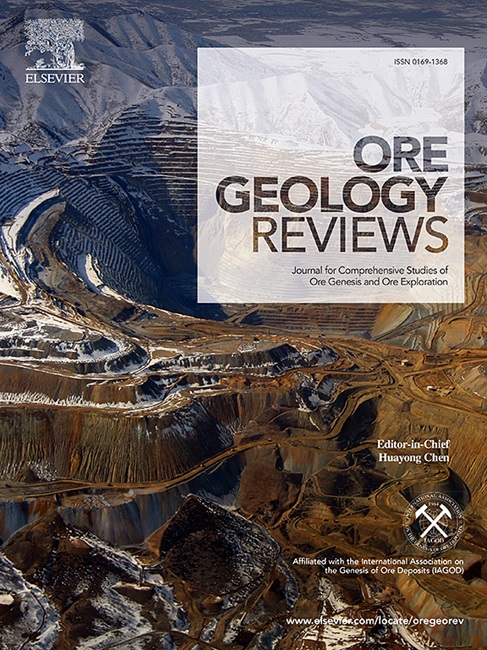Genesis and exploration potential of gold deposits in Archean high-amphibolite facies metamorphic rocks of the Jiaodong Peninsula: Geological and geochemical constraints from the Majiayao gold deposit
IF 3.2
2区 地球科学
Q1 GEOLOGY
引用次数: 0
Abstract
The Jiaodong Peninsula, China, hosts the giant Jiaodong gold province, containing over 5,800 tonnes of proven gold resources. While 87% of these deposits reside in Mesozoic granites, the remaining 11% occur within Archean metamorphic terranes. Notably, the origin, enrichment processes, and genetic model of the Majiayao gold deposit the largest hosted in Archean metamorphic rocks, remain poorly constrained. This study comprehensively analyzes the deposit geology, fluid inclusions, isotopes, and trace elements of the Majiayao deposit, aiming at clarifying the genesis of the deposit and perfecting the overall genetic model of Jiaodong gold deposits.
The Majiayao mineralization exhibited a four-stage sequence: (1) milky quartz-sericite, (2) quartz-pyrite, (3) quartz-siderite-polymetallic sulfide, and (4) quartz-carbonate. Detailed petrographic analyses identified three fluid inclusion types: H2O-CO2-NaCl ± CH4 (Type I), CO2 (Type II), and H2O-NaCl (Type III). Homogenization temperatures of fluid inclusions in the four stages (from early to late) ranged from 198-298 °C, 136–289 °C, 112–264 °C, and 139–179 °C, corresponding to salinities of 3.33–11.05 wt%, 2.77–12.51 wt%, 2.41–12.51 wt%, and 0.18–4.03 wt% NaCl equivalent. These data collectively suggest that the ore-forming fluids belong to a medium-temperature, medium–low salinity H2O-CO2-NaCl ± CH4 system, enriched in CO2 with minor CH4. This system evolved from medium to medium–low temperatures, shifting from CO2-rich to H2O-rich compositions, and from fluid immiscibility to fluid mixing. LA-ICP-MS analysis of pyrite revealed Au concentrations ranging from 0.008 to 12.909 ppm (median = 0.024 ppm) in Py2 and 0.025 to 2.330 ppm (median = 0.129 ppm) in py3. These results indicated extremely low invisible gold content associated with brittle deformation. The key mechanisms for gold mineralization were inferred to be sulfidation, characterized by the saturation and precipitation of abundant low-As pyrite and other sulfide minerals, alongside fluid phase separation.
Lead isotope compositions (206Pb/204Pb = 16.451–16.674, 207Pb/204Pb = 15.211–15.353, 208Pb/204Pb = 36.979–37.803) indicated that ore-forming materials likely originated from the lower crust. Compared to typical Jiaodong-type gold deposits, the Majiayao deposit exhibited similar fluid inclusion characteristics and H-O-S isotopic signatures, but with slightly lower mineralization temperatures, a narrower range of δ18OH2O values, and distinct lead isotope compositions. Compared to the depth of 5–9 km in Zhaoyuan-Laizhou gold belt, the Majiayao deposit displays a comparatively shallow estimated mineralization depth of 3.3–6.0 km, suggesting that the deep part of this region still has significant exploration potential.

胶东半岛太古代高角闪岩相变质岩中金矿成因及找矿潜力:来自马家窑金矿床的地质地球化学约束
中国胶东半岛拥有巨大的胶东黄金省,拥有超过5800吨已探明的黄金资源。这些矿床中87%位于中生代花岗岩中,其余11%位于太古宙变质地体中。值得注意的是,太古宙变质岩中最大的马家窑金矿床的成因、富集过程和成因模式尚不清楚。本文对马家窑金矿床的矿床地质、流体包裹体、同位素、微量元素等进行了综合分析,旨在明确矿床成因,完善胶东金矿床整体成因模式。马家窑矿化表现为4期序:(1)乳状石英绢云母、(2)石英黄铁矿、(3)石英菱铁矿多金属硫化物、(4)石英碳酸盐。详细的岩相分析发现三种流体包裹体类型:H2O-CO2-NaCl ± CH4 (I型)、二氧化碳(II型)和H2O-NaCl (III型)。利用流体包裹体均一化温度的四个阶段(从早期到晚期)范围从198 - 298年 °C, 136 - 289年 °C, 112 - 264年 °C,和139 - 179年 °C,对应的盐度3.33 - -11.05 wt %, 2.77 - -12.51 wt %, 2.41 - -12.51 wt %, -4.03和0.18 wt %氯化钠等价的。成矿流体属于中温、中低盐度H2O-CO2-NaCl ± CH4体系,富集CO2,少量CH4。该体系由中低温演化为中低温,组分由富co2变为富h2o,由流体非混相变为流体混合。LA-ICP-MS分析表明,Py2中Au的浓度范围为0.008 ~ 12.909 ppm( = 0.024 ppm), py3中Au的浓度范围为0.025 ~ 2.330 ppm( = 0.129 ppm)。这些结果表明,极低的不可见金含量与脆性变形有关。金矿化的关键机制是硫化作用,其特征是大量低砷黄铁矿和其他硫化物矿物的饱和和沉淀,并伴有流体相分离。铅同位素组成(206Pb/204Pb = 16.451 ~ 16.674,207Pb/204Pb = 15.211 ~ 15.353,208Pb/204Pb = 36.979 ~ 37.803)表明成矿物质可能来源于下地壳。马家窑金矿床流体包裹体特征和H-O-S同位素特征与典型胶东型金矿床相似,但成矿温度略低,δ18OH2O值范围窄,铅同位素组成明显。与昭源—莱州金带5 ~ 9 km的成矿深度相比,马家窑矿床成矿估计深度相对较浅,为3.3 ~ 6.0 km,表明该区深部仍有较大的找矿潜力。
本文章由计算机程序翻译,如有差异,请以英文原文为准。
求助全文
约1分钟内获得全文
求助全文
来源期刊

Ore Geology Reviews
地学-地质学
CiteScore
6.50
自引率
27.30%
发文量
546
审稿时长
22.9 weeks
期刊介绍:
Ore Geology Reviews aims to familiarize all earth scientists with recent advances in a number of interconnected disciplines related to the study of, and search for, ore deposits. The reviews range from brief to longer contributions, but the journal preferentially publishes manuscripts that fill the niche between the commonly shorter journal articles and the comprehensive book coverages, and thus has a special appeal to many authors and readers.
 求助内容:
求助内容: 应助结果提醒方式:
应助结果提醒方式:


